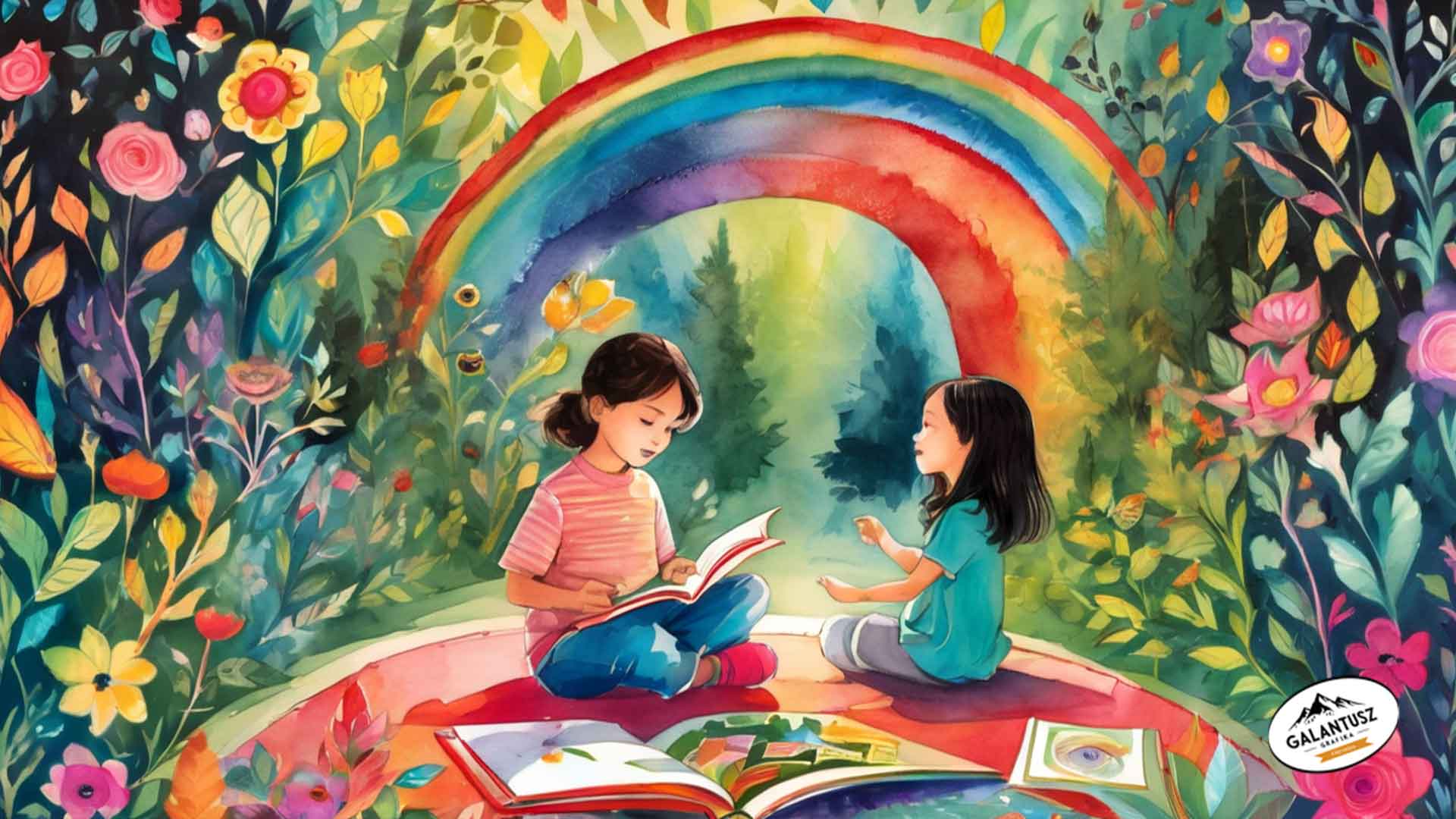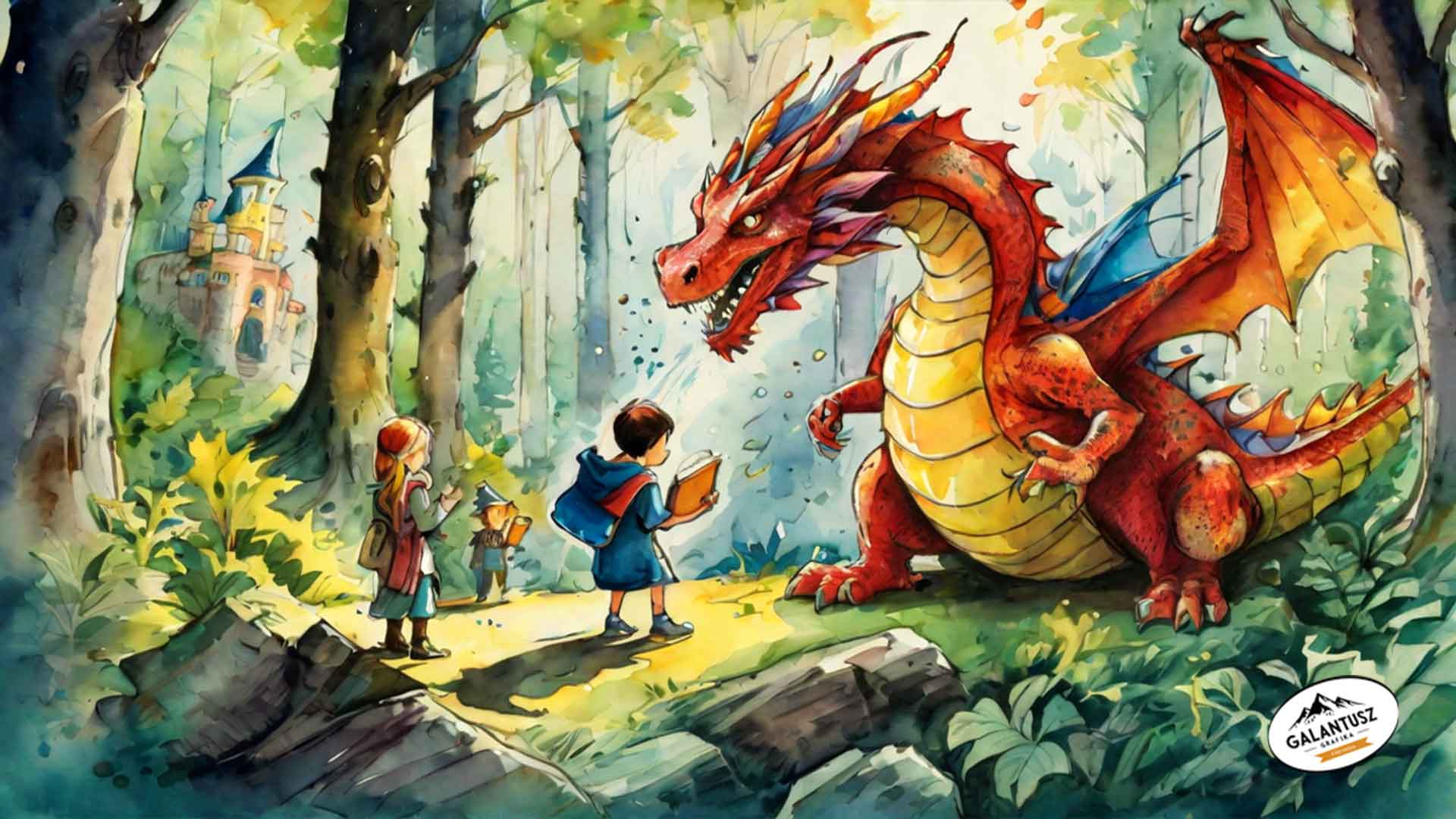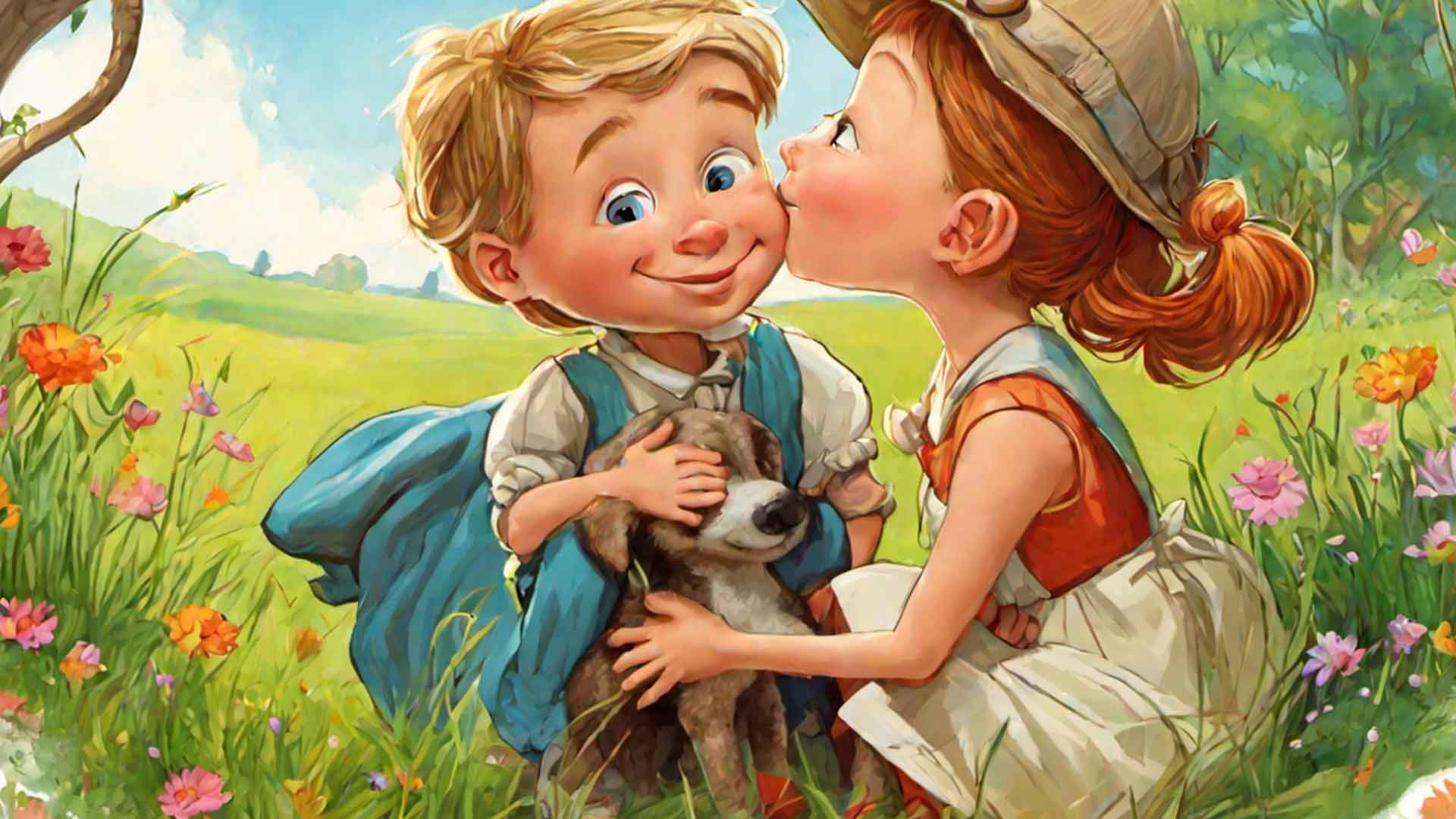Storybook illustration is not just about letting imagination take flight on paper; it is a complex form of communication that significantly influences how we perceive and interpret stories. Imagine storybooks without illustrations – just text trying to paint the world of the story. While words have immense power, adding illustrations opens up a new dimension where images and text work together to bring the story to life. This blog undertakes to present in detail the role and significance of storybook illustration, with special attention to how illustrated stories can help develop children's language skills and vocabulary. Let's dive together into this visually rich and colorful world, where art and words go hand in hand to develop and enrich the linguistic capabilities of the young mind.
The History of Storybook Illustration
The role of illustrations in storybooks is like the wave of a magic wand: it brings words to life, adding color and depth to the stories. The history of storybook illustration stretches back to ancient times when people drew their stories on cave walls, but the development of illustrations in printed storybooks dates to the 15th century, coinciding with the invention of printing.
In Europe, the golden age of book illustration was in the 19th century, when artists such as Gustave Doré, Arthur Rackham, and Edmund Dulac created unforgettable images that are still influential today. These illustrators, with their detailed, delicate line work, often in monochrome or limited color palettes, enchanted the stories and opened new dimensions in the reading experience.
Hungary also has rich traditions in storybook illustration. From the beginning of the 20th century, renowned Hungarian artists like Sándor Bortnyik and György Cserna appeared on the scene, visually interpreting the world of Hungarian folk tales. In the 1950s and 60s, the golden age of Hungarian illustration, creators such as László Réber or the illustrators of István Csukás's tales gained not only national but international recognition.
The Impact of Technology
With the advent of digital technology, storybook illustration has entered a new era. Alongside traditional hand-drawn illustrations, many illustrators now use digital tools, enabling them to work with unprecedented detail and color. This change has not only sped up and diversified the creation process but also opened new possibilities for the distribution and sharing of illustrations.
The history of storybook illustration thus reflects not only the development of the arts but also the permeability between cultures and the infinite possibilities of the human imagination. In Hungary and worldwide, illustrators continually seek new ways to combine storytelling and visual expression, ensuring that stories – and their illustrations – continue to enchant readers, regardless of their age.
Storybook Illustration as a Communication Tool
Storybook illustration is not just a visual complement to the text; it is a deeper form of communication that bridges the gap between words and imagination. Illustrations can convey a story's atmosphere, emotions, and messages directly, often without words. In this role, storybook illustration is particularly important for young readers, who are just beginning to learn about language and text comprehension.
Emotions and Atmosphere Conveyance
- Through illustrations, writers and illustrators can convey special emotions and atmospheres that would be difficult to express with words alone. A well-chosen image can help children better understand the nuances of the text, such as the characters' feelings or the mood of different story turns.
Bringing Characters and Settings to Life
- Illustrations give personality and face to the characters of stories. A well-designed illustration allows children to visually connect with the characters, deepening the reading experience. Similarly, illustrations of locations and story backgrounds help children immerse themselves more deeply in the story, facilitating full engagement during reading.
Developing Communication Skills
- Storybook illustrations not only enrich the story but also contribute to the development of children's communication skills. By analyzing illustrations, children learn how ideas and feelings can be expressed through images, encouraging them to think critically and communicate visually.
Cultural and Social Messages
Storybook illustrations play an important role in introducing children to different cultures and social messages. The diversity presented in illustrations – whether it involves characters of different ethnic backgrounds, various social situations, or even alternative family models – helps develop openness and empathy in children.
As a communication tool, therefore, storybook illustration is key to the development of childhood reading and text comprehension. Illustrations not only make stories more enjoyable and understandable but also contribute to the development of children's emotional intelligence, creativity, and communication skills. In this role, storybook illustration truly bridges the distance between words and imagination, opening the path to effective communication and the rich world of emotions.
Techniques and Styles of Storybook Illustration
The world of storybook illustration, with the diversity of techniques and styles, is like an endless palette that allows illustrators to bring stories to life in various ways and approaches. Each technique and style offers a unique mood and visual experience, enabling the reader to dive deeper into the world of stories. Let's review the most commonly used illustrative techniques and styles that come to life on the pages of storybooks.
Traditional Illustrative Techniques
- Watercolor: The watercolor technique enchants the reader with soft, translucent layers and delicate color gradients. This technique is particularly suitable for depicting fairy-tale, dreamlike scenes, where the blending of colors creates a unique atmosphere.
- Pen and Ink: Illustrations made with pen and ink stand out for their sharp line work and dynamic contours. This method is excellent for detailed character depiction and the precise capture of complex scenes.
- Linocut: Linocut is an older but still popular technique that creates strong contrasts and distinctive textures. Linocut illustrations result in characterful and stylized images that make a powerful visual impact.
Digital Illustration Techniques
- Digital Drawing: Digital drawing and painting mark a new era in illustrative techniques. Illustrators working on computers and graphic tablets can create complex, detailed images that mimic a wide range of traditional techniques or offer a completely new visual experience.
- Vector Graphics: Illustrations created with vector graphics offer clean lines and vibrant colors, allowing artists to produce scalable, detailed works. This technique is particularly suitable for creating modern, minimalist, or caricature-style illustrations.
Styles and Approaches
- Realistic: The aim of realistic illustrations is to depict characters and environments as lifelike as possible. These illustrations are intricately detailed, emphasizing shapes, textures, and lights to create a sense of reality.
- Stylized: Stylized illustrations move away from realistic depiction, focusing instead on artistic expression and characterful forms. This style allows illustrators to create a unique, easily recognizable visual language.
- Comic Style: Comic-style illustrations are dynamic and expressive, often including speech bubbles or thought clouds. This approach is particularly suitable for action-packed or humorous stories.
- Abstract: Abstract illustrations play with non-figurative forms, colors, and textures to create meaning. This style emphasizes the freedom of artistic expression, often conveying emotions and atmospheres without depicting specific objects.
The diversity of illustrative techniques and styles makes it possible for the illustrations in storybooks to offer the richest possible experience to readers. The specific technique or style used in individual works greatly contributes to the conveyance of the story's mood and message, enabling readers to fully immerse themselves in the magical world of stories.
The Process of Creating Illustrations
Creating illustrations is an artistic project based on the unique combination of creativity, technical skill, and storytelling. The creation of illustrations for storybooks is
not just a creative process; it is a carefully planned journey that involves several steps and requires close collaboration between the author, illustrator, and publisher. Let's see what steps this process involves and how it adapts to the variety of techniques and styles discussed in the previous chapter.
1. Getting to Know and Interpreting the Story
- First and foremost, the illustrator thoroughly familiarizes themselves with the story, its characters, locations, and mood. This phase is crucial, as it determines the visual style and technique that will best bring the story to life.
2. Designing Characters and Locations
- After analyzing the story, the illustrator develops sketches of the main characters and important locations. This may include sketching the characters' different emotions and movements, as well as designing the story's key locations. At this stage, the diversity of styles and techniques allows the illustrator to experiment and find the most suitable mode of representation.
3. Color and Texture
- After the sketchy design of characters and locations, the next step is adding colors and textures. In this phase, the illustrator decides on the color palette and textures that best reflect the mood of the work. Whether working with watercolor, digital, or other techniques, this step adds the final mood and depth to the illustrations.
4. Composition and Layout
- During the development of the composition, the illustrator decides how the characters and elements should be arranged on the pages. This includes the layout of the images, creating a balance between text and illustration, and ensuring that the visual elements help tell the story.
5. Refinement and Finalization
- The last step is refinement and finalization, when the illustrator reviews and perfects the illustrations. This may include precise detailing, fine-tuning colors and shadows, and correcting any errors. This stage often involves consultations with the publisher and author to ensure that every detail perfectly fits the book's concept.
This process of creating illustrations adapts to the variety of techniques and styles, allowing illustrators to fully utilize their creativity to bring stories to life. This process is not just an act of artistic expression but also a journey where words and images unite to collectively tell a story.
Developing Language Skills Through Storybook Illustrations
Storybook illustrations are not just aids to the imagination; they are significant tools for developing language skills. These visual works offer more than colorful accompaniment to the text; they are active participants in the learning process, especially in childhood, when processing visual information and developing language skills are crucial. Let's see how storybook illustrations contribute to the expansion of language capabilities.
Vocabulary Expansion and Contextual Understanding
The combination of images and text serves as a bridge between complex concepts and the words already known to the child. When a child sees an illustration related to a specific word, it helps them understand and remember that word, especially if it is new or complex. For example, if a story mentions a "sailboat" and is accompanied by an attractive illustration, the child can more easily associate the image with the concept, thus expanding their vocabulary.
Language Structures and Storytelling
Through storybook illustrations, children not only learn new words but also better understand language structures. The images help recognize the storyline, such as the introduction, plot, and conclusion. The visual environment provided by the illustrations contributes to the child's ability to understand the basic elements of storytelling, which later helps them formulate their own stories.
Emotional Intelligence and Language Expression
- Illustrations can depict emotions and moods, helping children expand their emotional vocabulary. By interpreting the characters' facial expressions and body language, children learn the names of emotions and ways to express them, contributing to the development of their emotional intelligence and language expressiveness.
Critical Thinking
- Storybook illustrations not only prompt children to interpret what they see literally but also to draw conclusions and think critically. For example, an illustration depicting a turning point in the story may encourage the child to guess about upcoming events. This type of interactive reading promotes language skills, including text comprehension and the ability to draw intertextual conclusions.
Cross-cultural Understanding
- Through illustrations depicting different cultures, children are introduced to new words and concepts related to other cultures. This not only enriches their vocabulary but also promotes cross-cultural understanding and openness, which is essential for the broad development of language skills.
Overall, the visual and contextual support provided by storybook illustrations is indispensable in the development of childhood language skills. These colorful, lively images not only stimulate the imagination but are also fundamental tools for language expression, critical thinking, and emotional intelligence development.
The Impact of Storybook Illustration on Child Development
The magical world of storybook illustrations is not just a tool for imagination; it deeply influences the comprehensive development of children. These visual creations play a key role in the development of cognitive, emotional, social, and language abilities, contributing to the harmonious growth of the child. Let's examine the positive effects of storybook illustration on child development.
Cognitive Skills and Creative Thinking
- Storybook illustrations stimulate a child's cognitive abilities, including problem-solving, logical thinking, and creativity. Interpreting images, following stories, and understanding cause-and-effect relationships contribute to cognitive development. The questions raised by illustrations and the challenges inherent in the stories encourage children to think, make assumptions, and become creators themselves.
Emotional Development and Empathy
- Through storybook illustrations, children can empathize with others, thus developing empathy and emotional intelligence. Identifying with the characters helps children understand and express their own feelings, as well as recognize and respect the feelings of others. This emotional connection promotes the child's emotional development, contributing to the formation of a sensitive and balanced personality.
Social Skills and Community Feeling
- Storybook illustrations can present different social situations, cultures, and lifestyles, helping children understand the diversity of the world. Developing a sense of community, tolerance, and openness to different cultures is essential in expanding a child's social skills. The shared experiences offered by illustrations, such as sharing and discussing stories, strengthen social bonds and promote group functioning skills.
Language Skills and Communication
As previously mentioned, storybook illustrations play a significant role in developing language skills. The combination of visual elements and text helps expand vocabulary, understand grammatical structures, and develop narrative skills. The inspiring effect of illustrations encourages children to speak and tell stories, contributing to the expansion of their communication abilities.
Therefore, storybook illustrations are not just aids to child imagination but are also fundamental building blocks of child development. These visual works encourage creative and critical thinking, support the development of emotional and social skills, and promote language and communication abilities. Storybook illustrations thus contribute to the formation of a versatile, sensitive, and intelligent personality capable of interpreting the world and communicating effectively with others.
Future Trends and Challenges in Storybook Illustration
The world of storybook illustration is constantly changing, as new technologies and social changes create new opportunities and challenges for artists and publishers. To understand the directions this art form might take in the future, it is important to examine current trends and look ahead to possible development directions. Below, we highlight some key areas that are expected to shape the future of storybook illustration.
Digital Technologies and Interactivity
The development of digital tools and platforms allows illustrators to approach storybook illustration in new ways. Technologies such as AR (Augmented Reality) and VR (Virtual Reality), as well as interactive e-books, open up new dimensions in storytelling, enabling children to become even more active participants in the stories.
Environmental Awareness and Social Messages
The growing importance of environmental awareness and commitment to social justice is increasingly reflected in children's literature. In the
future, more stories are expected to address these themes, which will visually appear through illustrations, promoting the development of children's awareness and empathy.
Diversity and Inclusion
The prominence of diversity and inclusion in illustrations is an important trend. Depicting characters from various cultural, ethnic, and social backgrounds, as well as people with different abilities, helps children understand and appreciate the diversity of the world.
Personalized Content
The demand for unique and personalized content is growing, opening up new opportunities for illustrators and publishers. Technological advancements enable personalized storybooks to become even more customized and interactive, providing a unique reading experience for every child.
Galantusz Graphics: Illustrating the Future
In light of these trends and challenges, Galantusz Graphics is ready to play a leading role in shaping the new era of storybook illustration. With our innovative approaches and the use of the latest technologies, our goal is to create immersive, educational, and visually stunning storybooks. From environmental awareness to social messages and the depiction of diversity and inclusion, Galantusz Graphics is committed to helping children's imagination take flight while contributing to the development of young readers.
Allow Galantusz Graphics to transform stories into not just readings but experiences that shape children's worldview, develop their language skills, and expand their emotional intelligence. Contact us, and let's explore together how we can bring the illustrations of the future to your story.






